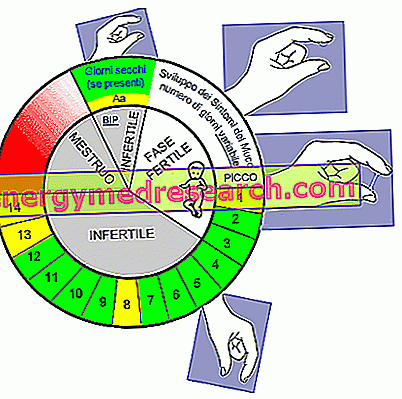Billings method
The Billings method is a natural tool for planning female fertility. Observing the characteristics of cervical mucus,

The Billings method is therefore a birth control tool because the couple can decide to use it not only to avoid an unwanted pregnancy, but also and above all to program it.
What to do if ...
- ... a couple wants a child. The Billings method allows the woman to identify the days of maximum fertility; therefore, the couple that wishes a pregnancy should consume full reports on days when the cervical mucus appears fluid and filamentous.
- ... a couple does not want a pregnancy. The Billings method can be interpreted in reverse: to avoid pregnancy, the woman should refrain from unprotected sex when the cervical mucus is flowing and sticky. Alternatively, during these "high risk" days, it is possible to use different and more reliable contraceptive methods (eg condom).
Advantages
Seen in a contraceptive key, the Billings method - which is one of the forms of natural contraception - is admitted by the Church. For many religious men and women, the "consensus" of the Church pushes the couple to regularly use this method to prevent an unwelcome pregnancy. For other couples, living sexuality without moral or religious bias favors greater understanding within the relationship itself. With the Billings method, the couple responsibly lives the procreative act, within a scenario of love for life and respect for religion.
The Billings method constitutes a discreet aid to contraception (or pro- conceptional) during the whole fertile period of the woman: breastfeeding, premenopausal, post-natal period, after an abortion, in the period of suspension of the estrogen progestins or IUD spiral etc ..
The Billings method - which requires an excellent knowledge and mastery of one's body - helps the woman to better understand every signal that the body sends her. An alteration of the cervical mucus, for example, can be interpreted by the woman as a light turned on of an intimate disorder at the initial stage, thus allowing it an immediate therapeutic intervention.
The Billings method, being completely natural, is free of contraindications and does not present the typical undesirable effects of some hormonal contraceptives (alterations of the menstrual cycle and mood, weight gain, general health ...); unfortunately, however, the degree of protection from unwanted pregnancies is not as high.
Disadvantages
The Billings contraceptive method is not infallible because many factors can interfere with analysis and evaluation of cervical mucus. Among these, we recall:
- Vaginal infections
- Internal vaginal lavages
- Administration of some drugs
- Sperm presence
- Use of vaginal eggs
- Spermicide use
- Use of lubricants
- Menstrual changes
- Stress
In the presence of one or more of these factors, the woman can confuse the less fertile days with the more fruitful ones.
In such circumstances, the Billings method may fail because the woman does not correctly interpret the characteristics of cervical mucus.
Another significant disadvantage is that the Billings method is NOT indicated for occasional relationships, as it does not protect in any way from sexually transmitted diseases.
The same Billings contraceptive practice is not indicated for young women who have just opened the doors to sexuality. In this case, the Billings method is not recommended because the very young do not yet know their body perfectly.
Finally, remember that, to take advantage of the maximum contraceptive effectiveness of the Billings method, the couple should refrain from unprotected sex for 14-17 days each cycle.
Contraceptive effectiveness
When compared to hormonal or implantable barrier contraceptive methods, the risk of failure of the Billings method is extremely high (3-22%). By adopting further measures, it is however possible to increase the contraceptive efficacy of the Billings method:
- Symptothermal method. It is based on the combined evaluation of several elements:
- changes in cervical mucus (Billings method)
- change in body temperature during the cycle (another natural contraceptive practice)
- physiological changes of the uterine cervix (detectable by cervical self-examination)
Normally, 3 days before and 3 days after the maximum basal temperature peak, the cervical mucus is particularly filamentous and fluid, and the uterine cervix is soft and dilated. During this time, to avoid pregnancy, the couple should refrain from unprotected sex.
- Billings method + interrupted coitus: also in this case, the two contraceptive methods are admitted by the Church. Interrupted intercourse involves the immediate and prompt interruption of sexual intercourse a few moments before ejaculation. During these moments, the man has to worry about directing the ejaculate away from the woman's external genitals.
- Billings method + barrier contraceptive. In this case, the combination of a natural method (Billings) with a mechanical contraceptive instrument (female condom, condom, diaphragm, cervical cap) effectively protects against unwanted pregnancies. Despite what has been said, the dual protection "natural + mechanical" is not admitted by the Church. However, the couple can decide freely whether to use more reliable or less contraceptive practices.
In conclusion, more than a contraceptive tool to prevent unwanted pregnancies, the Billings method should be interpreted from the opposite point of view. In fact, the Billings method proves to be an excellent tool for understanding what are the potentially most fruitful days of women.



